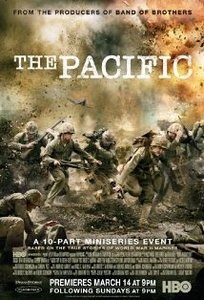 The Pacific (2010) – on HD. Of the many war and political history books that the late Professor Stephen Ambrose wrote, two of them particularly standout for me. One is Citizen Soldiers – which was in turn one of the main sources for Steven Spielberg’s Saving Private Ryan – and the other was Band of Brothers, which Spielberg would co-make with Tom Hanks into a 10 part mini-series that won heaps of awards.
The Pacific (2010) – on HD. Of the many war and political history books that the late Professor Stephen Ambrose wrote, two of them particularly standout for me. One is Citizen Soldiers – which was in turn one of the main sources for Steven Spielberg’s Saving Private Ryan – and the other was Band of Brothers, which Spielberg would co-make with Tom Hanks into a 10 part mini-series that won heaps of awards.
Shortly after the Band of Brothers (BoB) series was broadcast on HBO, the Pacific war veterans apparently all asked Spielberg, “What about us?” As I remember it; Ambrose was working on a new book covering the citizen soldiers’ experience in the Pacific theatre and had started collecting material from the veterans who fought in that campaign. But the good professor passed on shortly after commencing work on the book, which sort of left the book project in a limbo sort of state.
Truth to tell; the European theatre of operations – which we saw in BoB – was a very different experience from the Pacific campaign for the men who fought in them. For starters, as violent and brutal as the American citizen soldiers found fighting the Germans, there was never the kind of hatred and enmity that the Americans and Japanese had against each other in the Pacific campaign, to say nothing of the punishing tropical climates the campaign was waged in. So, unlike the war to liberate Europe from Nazi Germany between 1944 to 1945, the war between America and Japan in the Pacific between 1942 to 1945 seemed akin to one of extermination where the entrenched Japanese were determined to make the Americans pay with blood for every inch of soil they were giving up.
The Pacific is a ten part series released this year, and is based on the stories of three men who fought in it. Two of them – Robert Leckie and Eugene Sledge – survived the war and later went on to publish their memoirs, and the third, John Basilone, was a Medal of Honor recipient but who was unfortunately killed in the battle of Iwo Jima shortly thereafter. The two memoirs and Basilone’s well-documented story as he was the recipient of the highest decoration that the United States can award forms the source for the series.
It also doesn’t take long for a viewer to realize that while both Band of Brothers and The Pacific are helmed by the same persons, the production tone of both series feels very different, and it’s both good and bad. On the up side, the ten years since BoB has seen huge leaps in what computer wizardry can do for films, and apart from the night scenes which still have a sort of contained ‘studio-ish’ look, the visuals in The Pacific are stunning with no expense spared. Several scenes are standout, including the charge across the airfield against entrenched Japanese forces on Peleliu island, or the battle for Okinawa. The scenes here rival or even better anything you’ve seen in theaters… and best of all, it doesn’t look CGed.
The new series is also noticeably adopting a approach that tells the personal stories of all three individuals. If you think back to Band of Brothers, that series begins at boot camp, and ends in Austria shortly after Nazi Germany’s capitulation, and maintains its focus squarely on just the war dimension of the stories of the men the series is trying to tell. In The Pacific, the backstories of Leckie, Sledge and Basilone are all told in turn before they join the war, and when two return.
The series doesn’t shy away too from portraying acts of war violence, that unless you’re familiar with the campaign, might shock you. It certainly did for Ling, who turned to me several times throughout the series asking in no small measure of distress “Did that really happen dear?” There’re scenes of American medical corpsmen trying to tend to Japanese wounded only to get themselves blown into pieces because that Japanese wounded soldier was hiding a grenade in his last honorific to his Emperor. Or of the Japanese soldiers using civilians as human shields on Okinawa. Or of American soldiers using wounded enemy soldiers as target practice. Or the outcome of misfired American mortar shells landing on Japanese civilians. It’s painful to watch, but yet will leave you with indelible impressions of what war was and is like.
Continued in the next post.
The most moving scene for me is during the battle at Okinawa. A civilian woman was strapped with explosives (by Japanese soldiers) and forced to walk towards the American soldiers with her baby in her hands. The American soldiers did not shoot her but she was trembling and crying and begging them to take her baby. When her outer robe parted revealing the bomb, the soldiers dodged quickly before the bomb went off killing the woman and baby into pieces.